Echipa de cercetare Procese Induse cu Laser este implicată în cercetări legate de procesele fizico-chimice induse de radiația electromagnetică coerentă în interacție cu materia, de la atomi și molecule până la sisteme biologice și nanostructuri. Prin abordări teoretice şi experimentale încercăm să contribuim atât la înțelegerea fundamentală a acestor procese cât și la dezvoltarea de aplicații care le exploatează.
Tematici de cercetare:
- Caracterizarea temporală / spectrală a pulsurilor laser ultrascurte: exploatarea metodelor de deep learning; Proiecte: ELI-RO
- Propagarea pulsurilor de femtosecunde și generarea pulsurilor de attosecunde în circuite fotonice integrate fabricate cu laser: Proiecte în derulare: H2020 X-PIC, PN-III-P3-3.6-H2020
- Interacțiunea pulsurilor laser ultrascurte cu atomi: modelarea macroscopică a procesului de generare de armonici superioare și obținerea pulsurilor de attosecunde
- Analiza dinamicii stărilor electronice excitate induse de radiația electromagnetică coerentă în sisteme moleculare și supramoleculare; Proiecte: PN-III-P4-ID-PCE-2020-0770
- Fabricarea de filme nanostructurate cu proprietăți optice/plasmonice controlate prin auto-asamblare coloidală și litografie coloidală; Proiecte: PN-III-P4-ID-PCE-2020-1607
- Litografie prin scriere directă cu laser, de la nanostructuri până la structuri milimetrice
- Dezvoltarea de senzori optici moleculari exploatând efecte de amplificare plasmonică a interacțiunilor dintre lumina laser și analit (SERS, SEF). Proiecte: RO-NO-2019-0517, PN-III-P2-2.1-PED-2019-5473
- Fenomene ultrarapide fotoinduse în nanomateriale hibride metal-semiconductor investigate prin spectroscopie rezolvată în timp. Proiecte: PN-III-P1-1.1-TE-2019-1141
- Caracterizări prin tehnici de tomografie de coerență optică și dezvoltarea de agenți de contrast
- Determinarea parametrilor termici ai solidelor poroase prin calorimetrie fotopiroelectrică: dezvoltare metodologică și optimizarea condițiilor experimentale.
Lider de Echipă
Dr. Cosmin FARCĂU – Cercetător Științific I
Domeniu de expertiză: Auto-asamblări coloidale, Fabricarea de filme nanostructurate periodic, Spectroscopie Raman/SERS și de fluorescență, Proprietăți plasmonice (experiment și simulări FDTD).
Membri:
Dr. Attila BENDE – Cercetător Științific I
Domeniu de expertiză: Chimie teoretică, Fizică atomică și moleculară.
Drd. Maricel BOCĂNEALĂ – Asistent Cercetător
Domeniu de expertiză: Bioinformatica, Microbiologie.
Dr. Radu BRĂTFĂLEAN – Cercetător Științific II
Domeniu de expertiză: .
Drd. Denisa-Corina CUIBUS – Asistent Cercetător
Domeniu de expertiză: Nanoparticule și microparticule, UV-VIS.
Dr. Dorin Nicolae DĂDÂRLAT – Cercetător Științific I
Domeniu de expertiză: Fizica stării solide, Optica.
Dr. Alexandra FĂLĂMAȘ – Cercetător Științific II
Domeniu de expertiză: Optică, Fizică atomică și moleculară, Spectroscopie electronică.
Drd. Alex-Adrian FARCAȘ – Cercetător Științific III
Domeniu de expertiză: Fizică Atomică, Moleculară și Chimică, Chimie Teoretică, Chimie Fizică.
Dr. Ana Maria Mihaela GHERMAN – Cercetător Științific
Domeniu de expertiză: Optică, Fizică atomică și moleculară, Spectroscopie electronică, Spectroscopie rezolvată în timp.
Dr. Katalin KOVÁCS – Cercetător Științific I
Domeniu de expertiză: Optică neliniară, Interacție laser – materie, Fizica attosecundelor.
Ing. Ioana MARICA – Asistent Cercetător
Domeniu de expertiză: Spectroscopie vibrațională (Raman), Fizică atomică, moleculară și optică, Spectroscopie de absorbție și fluorescență.
Dr. Cristina MUNTEAN – Cercetător Științific I
Domeniu de expertiză: Spectroscopia vibrațională a acizilor nucleici.
Dr. Fran NEKVAPIL – Asistent Cercetător
Domeniu de expertiză: Mediu acvatic, Acuacultură, Biologie marină, bioeconomie și cercetarea reciclării biomaterialelor, Bio-nanomateriale: sinteză și caracterizare prin metode spectroscopice și imagistice, Analiza spectroscopică a țesuturilor, Biomineralizare, Chimie alimentară.
Dr. Florin TOADERE – Cercetător Științific III
Domeniu de expertiză: Prelucrări de imagini, OCT, Spectroscopie VIS.
Dr. Nicoleta TOȘA – Cercetător Științific II
Domeniu de expertiză: Chimie organică, anorganică şi analitică, Chimie fizică, Spectroscopie, Știinţa şi ingineria materialelor.
Dr. Valer TOȘA – Cercetător Științific I
Domeniu de expertiză: Generare armonici superioare și pulsuri de attosecunde, Propagarea pulsurilor femtosecunde în gaze ionizante și configurații ghidate, Modelarea migrației în structuri multistrat.
Dr. István Ferenc TÓTH – Cercetător Științific III
Domeniu de expertiză: .
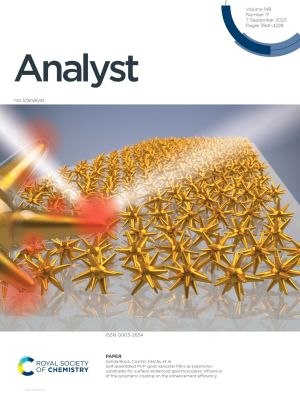 Self-assembled PVP-gold nanostar films as plasmonic substrates for surface-enhanced spectroscopies: influence of the polymeric coating on the enhancement efficiency, Journal Cover
Self-assembled PVP-gold nanostar films as plasmonic substrates for surface-enhanced spectroscopies: influence of the polymeric coating on the enhancement efficiency, Journal Cover
Andra-Sorina Tatar, Sanda Boca, Alexandra Fălămaș, Denisa Cuibus and Cosmin Farcău
Abstract: Colloidal nanoparticles exhibiting anisotropic morphologies are preferred in the structural design of spectroscopically active substrates due to the remarkable optical properties of this type of nano-object. In the particular case of star-like nanoparticles, their sharp tips can act as antennae for capturing and amplifying the incident light, as well as for enhancing the light emitted by nearby fluorophores or the scattering efficiency of Raman active molecules. In the current work, we aimed to implement such star-shaped nanoparticles in the fabrication of nanoparticle films and explore their use as solid plasmonic substrates for surface-enhanced optical spectroscopies. High-density, compact and robust self-assembled gold nanostar films were prepared by directly depositing them from aqueous colloidal suspension on polystyrene plates through convective self-assembly. We investigated the role of the polymeric coating, herein polyvinylpyrrolidone (PVP), in the particle assembly process, the resulting morphology and consequently, the plasmonic response of the obtained films. The efficacy of the plasmonic films as dual-mode surface-enhanced fluorescence (SEF) and surface-enhanced Raman scattering (SERS) substrates was evidenced by testing Nile Blue A (NB) and Rhodamine 800 (Rh800) molecular chromophores under visible (633 nm) versus NIR (785 nm) laser excitation. Steady-state and time-resolved fluorescence investigations highlight the fluorescence intensity and fluorescence lifetime modification effects. The experimental results were corroborated with theoretical modelling by finite-difference time-domain (FDTD) simulations. Furthermore, to prove the extended applicability of the proposed substrates in the detection of biologically relevant molecules, we tested their SERS efficiency for sensing metanephrine, a metabolite currently used for the biochemical diagnosis of neuroendocrine tumors, at concentration levels similar to other catecholamine metabolites.
Toward microfluidic SERS and EC-SERS applications via tunable gold films over nanospheres
Alexandra Fălămaș, Denisa Cuibus, Nicoleta Tosa, Ioana Brezestean, Cristina M. Muntean, Karolina Milenko, Elizaveta Vereshchagina, Rebeca Moldovan, Ede Bodoki and Cosmin Farcău
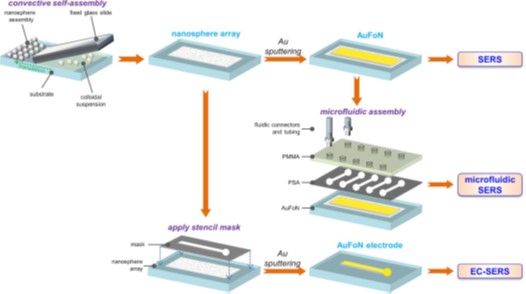 Abstract: Many promising applications of surface-enhanced Raman scattering (SERS), such as microfluidic SERS and electrochemical (EC)-SERS, require immersion of plasmonic nanostructured films in aqueous media. Correlational investigations of the optical response and SERS efficiency of solid SERS substrates immersed in water are absent in the literature. This work presents an approach for tuning the efficiency of gold films over nanospheres (AuFoN) as SERS substrates for applications in aqueous environment. AuFoN are fabricated by convective self-assembly of colloidal polystyrene nanospheres of various diameters (300–800 nm), followed by magnetron sputtering of gold films. The optical reflectance of the AuFoN and Finite-Difference Time-Domain simulations in both water and air reveal the dependence of the surface plasmon band on nanospheres’ diameter and environment. SERS enhancement of a common Raman reporter on AuFoN immersed in water is analyzed under 785 nm laser excitation, but also using the 633 nm line for the films in air. The provided correlations between the SERS efficiency and optical response in both air and water indicate the best structural parameters for high SERS efficiency and highlight a route for predicting and optimizing the SERS response of AuFoN in water based on the behavior in air, which is more practical. Finally, the AuFoN are successfully tested as electrodes for EC-SERS detection of the thiabendazole pesticide and as SERS substrates integrated in a flow-through microchannel format. The obtained results represent an important step toward the development of microfluidic EC-SERS devices for sensing applications.
Abstract: Many promising applications of surface-enhanced Raman scattering (SERS), such as microfluidic SERS and electrochemical (EC)-SERS, require immersion of plasmonic nanostructured films in aqueous media. Correlational investigations of the optical response and SERS efficiency of solid SERS substrates immersed in water are absent in the literature. This work presents an approach for tuning the efficiency of gold films over nanospheres (AuFoN) as SERS substrates for applications in aqueous environment. AuFoN are fabricated by convective self-assembly of colloidal polystyrene nanospheres of various diameters (300–800 nm), followed by magnetron sputtering of gold films. The optical reflectance of the AuFoN and Finite-Difference Time-Domain simulations in both water and air reveal the dependence of the surface plasmon band on nanospheres’ diameter and environment. SERS enhancement of a common Raman reporter on AuFoN immersed in water is analyzed under 785 nm laser excitation, but also using the 633 nm line for the films in air. The provided correlations between the SERS efficiency and optical response in both air and water indicate the best structural parameters for high SERS efficiency and highlight a route for predicting and optimizing the SERS response of AuFoN in water based on the behavior in air, which is more practical. Finally, the AuFoN are successfully tested as electrodes for EC-SERS detection of the thiabendazole pesticide and as SERS substrates integrated in a flow-through microchannel format. The obtained results represent an important step toward the development of microfluidic EC-SERS devices for sensing applications.
A simple approach for coffee-ring suppression yielding homogeneous drying patterns of ZnO and TiO2 nanoparticles
Ioana Marica, Maria Ștefan, Sanda Boca, Alexandra Fălămaș, Cosmin Farcău
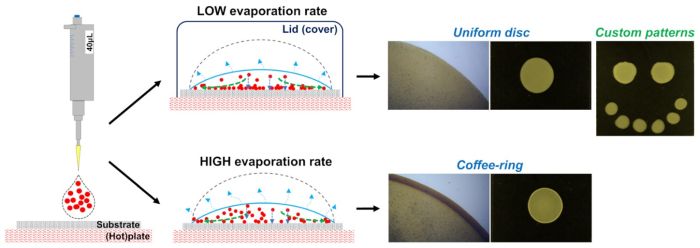 Abstract: Evaporation-induced self-assembly in colloidal droplets is a method for organising nanoparticles on substrates, with various resulting patterns. The coffee-ring pattern is among the most common ones, but its non-uniformity limits its applicability, which led to efforts for developing coffee-ring suppression strategies. Considering the wide applicability of ZnO and TiO2 nanoparticles, there is a high demand for practical means to deposit them as uniform films. Here, we present a simple approach for obtaining highly uniform thin films of ZnO and TiO2 nanoparticles by drop-coating in ambient conditions, without using surfactants or other surface chemistry modifications. Disc-like films were obtained via a restricted evaporation achieved by covering the droplets with a lid during drying, seconded by the relatively high sedimentation rate of these nanoparticles. To better understand the assembly mechanism, the influence of suspension concentration, type and temperature of the substrate, droplet volume, colloid type, and evaporation rate were studied. The method allows preparing disc-like nanoparticle films with a good control over their diameter and thickness, onto different kinds of substrates (glass, Si, polyethylene terephthalate, polystyrene). By fabricating both two-dimensional lattices and custom disc patterns we highlight the versatility of this drop-coating method and its potential for, e.g., automatized serial production processes.
Abstract: Evaporation-induced self-assembly in colloidal droplets is a method for organising nanoparticles on substrates, with various resulting patterns. The coffee-ring pattern is among the most common ones, but its non-uniformity limits its applicability, which led to efforts for developing coffee-ring suppression strategies. Considering the wide applicability of ZnO and TiO2 nanoparticles, there is a high demand for practical means to deposit them as uniform films. Here, we present a simple approach for obtaining highly uniform thin films of ZnO and TiO2 nanoparticles by drop-coating in ambient conditions, without using surfactants or other surface chemistry modifications. Disc-like films were obtained via a restricted evaporation achieved by covering the droplets with a lid during drying, seconded by the relatively high sedimentation rate of these nanoparticles. To better understand the assembly mechanism, the influence of suspension concentration, type and temperature of the substrate, droplet volume, colloid type, and evaporation rate were studied. The method allows preparing disc-like nanoparticle films with a good control over their diameter and thickness, onto different kinds of substrates (glass, Si, polyethylene terephthalate, polystyrene). By fabricating both two-dimensional lattices and custom disc patterns we highlight the versatility of this drop-coating method and its potential for, e.g., automatized serial production processes.
Journal: Journal of Colloid and Interface Science Vol. 635, 117–127 (2023)
Review on combining surface-enhanced Raman spectroscopy and electrochemistry for analytical applications
Rebeca Moldovan, Elizaveta Vereshchagina, Karolina Milenko, Bogdan-Cezar Iacob, Andreea Elena Bodoki, Alexandra Fălămaș, Nicoleta Toșa, Cristina M. Muntean, Cosmin Farcău, Ede Bodoki
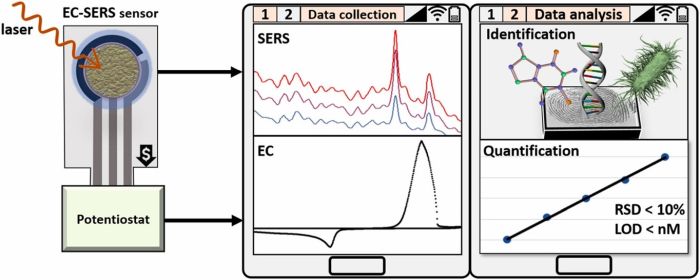 Abstract: The discovery of surface enhanced Raman scattering (SERS) from an electrochemical (EC)-SERS experiment is known as a historic breakthrough. Five decades have passed and Raman spectroelectrochemistry (SEC) has developed into a common characterization tool that provides information about the electrode electrolyte interface. Recently, this technique has been successfully explored for analytical purposes. EC was found to highly improve the performances of SERS sensors, providing, among others, controlled adsorption of analytes and increased reproducibility. In this review, we highlight the potential of EC-SERS sensors to be implemented for point-of-need (PON) analyses as miniaturized devices, and their ability to revolutionize fields like quality control, diagnosis or environmental and food safety. Important developments have been achieved in Raman spectroelectrochemistry, which now represents a promising alternative to conventional analytical methods and interests more and more researchers. The studies included in this review open endless possibilities for real-life EC-SERS analytical applications.
Abstract: The discovery of surface enhanced Raman scattering (SERS) from an electrochemical (EC)-SERS experiment is known as a historic breakthrough. Five decades have passed and Raman spectroelectrochemistry (SEC) has developed into a common characterization tool that provides information about the electrode electrolyte interface. Recently, this technique has been successfully explored for analytical purposes. EC was found to highly improve the performances of SERS sensors, providing, among others, controlled adsorption of analytes and increased reproducibility. In this review, we highlight the potential of EC-SERS sensors to be implemented for point-of-need (PON) analyses as miniaturized devices, and their ability to revolutionize fields like quality control, diagnosis or environmental and food safety. Important developments have been achieved in Raman spectroelectrochemistry, which now represents a promising alternative to conventional analytical methods and interests more and more researchers. The studies included in this review open endless possibilities for real-life EC-SERS analytical applications.
Journal: Analytica Chimica Acta. Vol. 1209, Art. Nr. 339250 (2022)
 Photoionization, Structures, and Energetics of Na-Doped Formic Acid–Water Clusters, Journal Cover
Photoionization, Structures, and Energetics of Na-Doped Formic Acid–Water Clusters, Journal Cover
Attila Bende, Maria F. Gaele and Tonia M. Di Palma
Abstract: The influence of formic acid on water cluster aggregation hasbeen investigated experimentally by mass spectrometry andtunable UV laser ionization applied to Na-doped clusters formedin the supersonic expansion of water vapors seeded with formicacid (FA) as well as theoretically using high level quantumchemistry methods. The mass spectra of Na-FA(H2O)n clustersshow an enlarging of mass distribution toward heavier clusterswith respect to the Na-(H2O)n clusters, suggesting similar massdistribution in neutral clusters and an influence of formic acid inwater aggregation. Density functional theory and coupled-clustertype (DLPNO-CCSD(T)) calculations have been used tocalculate structures and energetics of neutral and ionizedNa-FA(H2O)n as well as neutral FA(H2O)n. Na-doped clusters arecharacterized by very stable geometries. The theoreticaladiabatic ionization potential values match pretty well themeasured appearance energies and the calculated first sixelectronic excited states show Rydberg-type characters, indicatingpossible autoionization contributions in the mass spectra.Finally, theoretical calculations on neutral FA(H2O)n clustersshow the possibility of similarly stable structures in smallclusters containing up to n=4–5 water molecules, where FAinteracts significantly with waters. This suggests that FA cancompete with water molecules in the starting stage of theaggregation process, by forming stable nucleation seed.
Journal: ChemPhysChem, Vol. 23, Iss. 5 Art. Nr. e202100861 (2022)
 Compact intense extreme-ultraviolet source
Compact intense extreme-ultraviolet source
B. Major, O. Ghafur, K. Kovács, K. Varju, V. Toșa, M. J. J. Vrakking, B. Schutte
Abstract: High-intensity laser pulses covering the ultraviolet to terahertz spectral regions are nowadays routinely generated in a large number of laboratories. In contrast, intense extreme-ultraviolet (XUV) pulses have only been demonstrated using a small number of sources including free-electron laser facilities and long high-harmonic generation (HHG) beamlines. Here, we demonstrate a concept for a compact intense XUV source based on HHG that is focused to an intensity of 2 x 1014 W/cm2, with a potential increase up to 1017 W/cm2 in the future. Our approach uses tight focusing of the near-infrared (NIR) driving laser and minimizes the XUV virtual source size by generating harmonics several Rayleigh lengths away from the NIR focus. Accordingly, the XUV pulses can be refocused to a small beam waist radius of 600 nm, enabling the absorption of up to four XUV photons by a single Ar atom in a setup that fits on a modest (2 m) laser table. Our concept represents a straightforward approach for the generation of intense XUV pulses in many laboratories, providing exciting opportunities for XUV strong-field and nonlinear optics experiments, for XUV-pump XUV-probe spectroscopy and for the coherent diffractive imaging of nanoscale structures.
Generation of two successive attosecond pulses in separate spectral domains
K. Kovács and V. Toșa
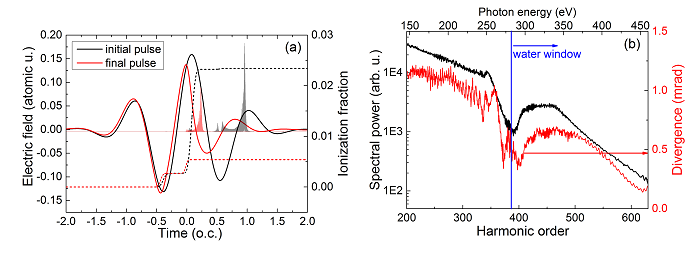 Abstract: We demonstrate that two different single attosecond pulses (SAP) can be obtained from naturally separated spectral domains formed during high-order harmonic generation and propagation in a gas medium. We propose a feasible experimental configuration in which one can obtain an SAP in a lower energy domain (<300 eV), or another SAP in a higher energy domain (>300 eV). Without filtering, a double attosecond pulse emission with fixed temporal separation is obtained. The gap between the two spectral domains is close to the onset of the water window.
Abstract: We demonstrate that two different single attosecond pulses (SAP) can be obtained from naturally separated spectral domains formed during high-order harmonic generation and propagation in a gas medium. We propose a feasible experimental configuration in which one can obtain an SAP in a lower energy domain (<300 eV), or another SAP in a higher energy domain (>300 eV). Without filtering, a double attosecond pulse emission with fixed temporal separation is obtained. The gap between the two spectral domains is close to the onset of the water window.
 Tunable plasmonic response of metal-coated microsphere arrays
Tunable plasmonic response of metal-coated microsphere arrays
N. Nechita and C. Farcău
Abstract: The overall optical response (transmittance, reflectance, and absorbance) of metal film over nanospheres (MFoN) is studied for a wide range of sphere diameters (200 – 1000 nm) and metal film thicknesses (40-200 nm), over the 450 – 2000 nm spectral range. Analyses are performed also in water, with microfluidic surface-enhanced Raman scattering applications in mind. Two main outcomes are the dependence of the plasmonic absorbance band on structural parameters and the behavior in aqueous environment. The parameter ranges for targeting common lasers (633 and 785 nm) are identified. Additionally, for larger sphere size and thicker films, a new absorbance band was identified, exhibiting a multipole-like electric field distribution, different than the dipole-like fields at the main absorption band. It is also shown that the fine morphology of the metal film at the inter-sphere region has a strong impact on reflectance (and absorbance) but not transmittance. The individual roles of the metal particles formed on the substrate or the dielectric sphere array on the overall optical response are discussed. Finally, the role of the metal type (Au, Ag, Cu, Al) is also analyzed.
Plasmonic photothermal heating of gold nanostars
A. M. M. Gherman, S. Boca, A. Vulpoi, M. V. Cristea, C. Farcău and V. Toșa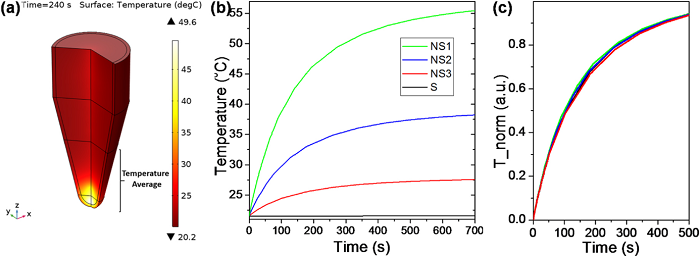 Abstract: The ability of noble metal nanoparticles (NPs) to convert light into heat has triggered a lot of scientific interest due to the numerous potential applications, including, e.g. photothermal therapy or laser-based nanopatterning. In order for such applications to be practically implemented, the heating behaviour of NPs embedded in their surrounding medium has to be thoroughly understood, and theoretical models capable of predicting this behaviour must be developed. Here we propose a multiscale approach for modelling the photothermal response of a large ensemble of nanoparticles contained within a cm-scale, real-size container. Electromagnetic field, ray tracing and heat transfer simulations are combined in order to model the response of nanostars and nanospheres suspensions contained within a common Eppendorf tube. To validate the model, gold nanostars are then synthesised and characterized by electron microscopy and optical spectroscopy. Laser-induced heating experiments are conducted by irradiating colloid-filled Eppendorf tubes with a 785 nm continuous wave laser and monitoring by a thermographic camera. The experimental results confirm that the proposed model has potential for predicting and analysing the heating efficiency and temperature dynamics upon laser irradiation of plasmonic nanoparticle suspensions in real-scale containers, at cm3 volumes.
Abstract: The ability of noble metal nanoparticles (NPs) to convert light into heat has triggered a lot of scientific interest due to the numerous potential applications, including, e.g. photothermal therapy or laser-based nanopatterning. In order for such applications to be practically implemented, the heating behaviour of NPs embedded in their surrounding medium has to be thoroughly understood, and theoretical models capable of predicting this behaviour must be developed. Here we propose a multiscale approach for modelling the photothermal response of a large ensemble of nanoparticles contained within a cm-scale, real-size container. Electromagnetic field, ray tracing and heat transfer simulations are combined in order to model the response of nanostars and nanospheres suspensions contained within a common Eppendorf tube. To validate the model, gold nanostars are then synthesised and characterized by electron microscopy and optical spectroscopy. Laser-induced heating experiments are conducted by irradiating colloid-filled Eppendorf tubes with a 785 nm continuous wave laser and monitoring by a thermographic camera. The experimental results confirm that the proposed model has potential for predicting and analysing the heating efficiency and temperature dynamics upon laser irradiation of plasmonic nanoparticle suspensions in real-scale containers, at cm3 volumes.
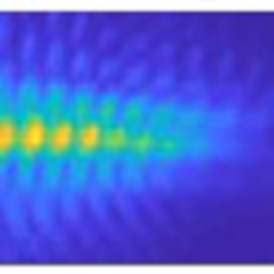
Propagation-enhanced generation of intense high-harmonic continua in the 100-eV spectral region
D. E. Rivas, B. Major, M. Weidman, W. Helml, G. Marcus, R. Kienberger, D. Charalambidis, P. Tzallas, E. Balogh, K. Kovács, V. Toșa, B. Bergues, K. Varjú, and L. Veisz
Abstract: The study of core electron dynamics through nonlinear spectroscopy requires intense isolated attosecond extreme ultraviolet or even X-ray pulses. A robust way to produce these pulses is high-harmonic generation (HHG) in a gas medium. However, the energy upscaling of the process depends on a very demanding next-generation laser technology that provides multi-terawatt (TW) laser pulses with few-optical-cycle duration and controlled electric field. Here, we revisit the HHG process driven by 16-TW sub-two-cycle laser pulses to reach high intensity in the 100-eV spectral region and beyond. We show that the combination of above barrier-suppression intensity with a long generation medium significantly enhances the isolation of attosecond pulses compared to lower intensities and/or shorter media and this way reduces the pulse duration as well as field-stability requirements on the laser driver. This novel regime facilitates the real-time observation of electron dynamics at the attosecond timescale in atoms, molecules, and solids.
Journal: Optica Vol. 5, Issue 10, pp. 1283-1289 (2018)
Light-induced spin transitions in Ni(II)-based macrocyclic-ligand complexes: A DFT study
Alex-Adrian Farcaș, Titus A. Beu and Attila Bende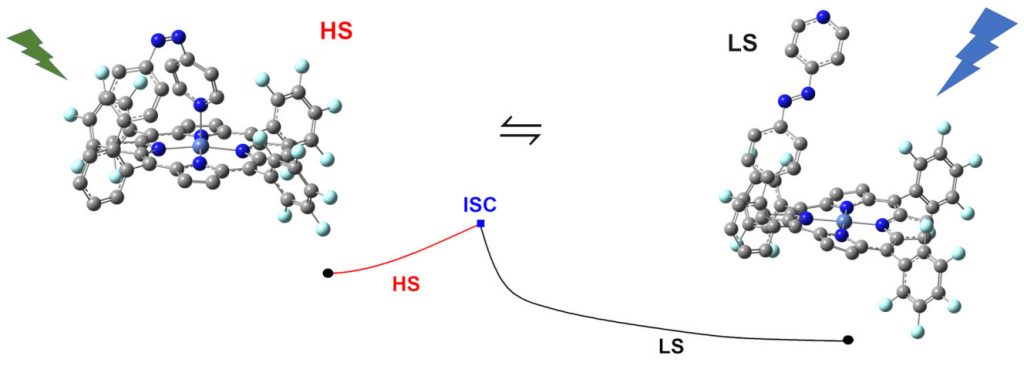 Abstract: Light-induced intersystem crossings in different Ni(II) macrocyclic ligand complexes with square-pyramidal and octahedral ligand-metal coordination have been investigated by means of static (DFT) and time-dependent density functional theory (TD-DFT) calculations, considering the MN12-SX exchange-correlation (XC) functional together with the def2-TZVP basis set. For the quantitative validation of the applied XC functional, the theoretical UV absorption spectra of azopyridine functionalized Ni-porphyrin macrocyclic ligand complex with square-pyramidal coordination have been compared with the experimental results obtained by Venkataramani et al. (Science, 331 (2011) 445). Using the TD-DFT method, the stability of the light–mediated reversible ligand coordination and the switching of magnetic properties have been characterized by identifying the active electronic excited states both in singlet and triplet spin configuration involved in the light-induced excited spin-state trapping. The location of the intersystem crossing points between different spin states has been performed and the strength of the spin-orbit coupling between them has been computed.
Abstract: Light-induced intersystem crossings in different Ni(II) macrocyclic ligand complexes with square-pyramidal and octahedral ligand-metal coordination have been investigated by means of static (DFT) and time-dependent density functional theory (TD-DFT) calculations, considering the MN12-SX exchange-correlation (XC) functional together with the def2-TZVP basis set. For the quantitative validation of the applied XC functional, the theoretical UV absorption spectra of azopyridine functionalized Ni-porphyrin macrocyclic ligand complex with square-pyramidal coordination have been compared with the experimental results obtained by Venkataramani et al. (Science, 331 (2011) 445). Using the TD-DFT method, the stability of the light–mediated reversible ligand coordination and the switching of magnetic properties have been characterized by identifying the active electronic excited states both in singlet and triplet spin configuration involved in the light-induced excited spin-state trapping. The location of the intersystem crossing points between different spin states has been performed and the strength of the spin-orbit coupling between them has been computed.
Journal: Journal of Photochemistry and Photobiology A: Chemistry Vol. 376, pp. 316-323 (2019)
Artificial Neural Network Trained to Predict High-Harmonic Flux
Ana Maria Mihaela Gherman, Katalin Kovács, Mircea Vasile Cristea and Valer Toșa Abstract: In this work we present the results obtained with an artificial neural network (ANN) which we trained to predict the expected output of high-order harmonic generation (HHG) process, while exploring a multi-dimensional parameter space. We argue on the utility and efficiency of the ANN model and demonstrate its ability to predict the outcome of HHG simulations. In this case study we present the results for a loose focusing HHG beamline, where the changing parameters are: the laser pulse energy, gas pressure, gas cell position relative to focus and medium length. The physical quantity which we predict here using ANN is directly related to the total harmonic yield in a specified spectral domain (20–40 eV). We discuss the versatility and adaptability of the presented method.
Abstract: In this work we present the results obtained with an artificial neural network (ANN) which we trained to predict the expected output of high-order harmonic generation (HHG) process, while exploring a multi-dimensional parameter space. We argue on the utility and efficiency of the ANN model and demonstrate its ability to predict the outcome of HHG simulations. In this case study we present the results for a loose focusing HHG beamline, where the changing parameters are: the laser pulse energy, gas pressure, gas cell position relative to focus and medium length. The physical quantity which we predict here using ANN is directly related to the total harmonic yield in a specified spectral domain (20–40 eV). We discuss the versatility and adaptability of the presented method.
Journal: Applied Sciences Vol. 8, Issue 11, Art. Nr. 2106 (2018)
 Macroscopic attosecond chirp compensation
Macroscopic attosecond chirp compensation
Katalin Kovács and Valer Toșa
Abstract: We numerically study the physical mechanism of the chirp compensation of the attosecond XUV pulses obtained by high-order harmonic generation. We show by detailed analysis that the macroscopic aspects of fundamental pulse propagation are essential in the formation and temporal-spectral-spatial properties of the attosecond pulses. Partial chirp compensation is already achievable due to the self-phase-modulation of the fundamental pulse. Further, by propagating the attosecond pulses in preformed plasma, we can fully compensate the inherent positive chirp of the attosecond pulses which were built up from the short electron trajectories in the harmonic generation process.
Journal: Optics Express Vol. 27, Issue 15, Art. Nr. 21873 (2019)
 Metal-coated microsphere monolayers as surface plasmon resonance sensors operating in both transmission and reflection modes
Metal-coated microsphere monolayers as surface plasmon resonance sensors operating in both transmission and reflection modes
Cosmin Farcău
Abstract: Metal-coated microsphere monolayers (MCM) are a class of plasmonic crystals consisting of noble metal films over arrays of self-assembled colloidal microspheres. Despite their ease of fabrication and tunable plasmonic response, their optical sensing potential has been scarcely explored. Here, silver coated polystyrene sphere monolayers are proposed as surface plasmon resonance sensors capable of functioning in both transmission (T) and reflection (R) readout modes. An original and key point is the use of ~200 nm colloids, smaller than in MCM studied before. It allowed us to reveal a previously unobserved, additional/secondary Enhanced Optical Transmission band, which can be exploited in sensing, with higher sensitivity than the better-known main transmission band. The reflection configuration however, is almost an order of magnitude more efficient for sensing than the transmission one. We also evidenced a strong impact of the adsorbate location on the metal surface on the sensing efficiency. Electric field distribution analysis is performed to explain these results. Proof-of-concept experiments on the detection of 11-MUA molecular monolayers, performed in both readout modes, confirm the behaviors observed through FDTD simulations. Results in this paper can serve as guidelines for designing optimized sensors based on metal-coated colloidal monolayers, and more generally for plasmonic sensors based on metal nanostructured films.
Journal: Scientific Reports Vol. 9, Art. Nr. 3683 (2019)
Graphene/silver nanoparticles‐based surface-enhanced Raman spectroscopy detection platforms: Application in the study of DNA molecules at low pH
Cristina M. Muntean, Nicoleta E. Dina, Maria Coroş, Nicoleta Toşa, Alexandru I. Turza and Monica Dan Abstract: The aim of this work is to develop a SERS-active platform based on a mixture of graphene/Ag nanocomposite and a silver colloid for biomedical applications and to test it in the case of DNA molecules at low pH. Graphene/silver nanocomposites were synthesized by the reduction process and were characterized by Transmission Electron Microscopy (TEM), X-ray diffraction (XRD) patterns and thermogravimetric analysis (TGA). The following graphene/Ag composites were prepared: a) TRGO („Thermally Reduced Graphene Oxide”), containing about 2-3% silver nanoparticles (AgNPs); b) TRGO 1 (graphene with crowded AgNPs 20%) and c) TRGO 2 (graphene with ordered AgNPs 20%). Different mixtures of these systems with a silver colloid were tested by UV-Vis spectrophotometry and also by surface-enhanced Raman spectroscopy (SERS) in the presence of the test substance crystal violet. Moreover, the time stability of the mixtures of graphene/AgNPs composite (TRGO 1) with the silver colloid was tested for crystal violet. Based on these results, the platform with the best SERS enhancement properties was selected for DNA analyses at low pH values. Chemical stability under acidic conditions has been found for nucleic acid systems, in the presence of graphene/crowded AgNPs 20% and silver colloid. This chemical stability has been discussed considering a hydracid catalyzed electrophilic hydration reaction mechanism characteristic to the trans-1,3-butadiene type building moieties from graphene.
Abstract: The aim of this work is to develop a SERS-active platform based on a mixture of graphene/Ag nanocomposite and a silver colloid for biomedical applications and to test it in the case of DNA molecules at low pH. Graphene/silver nanocomposites were synthesized by the reduction process and were characterized by Transmission Electron Microscopy (TEM), X-ray diffraction (XRD) patterns and thermogravimetric analysis (TGA). The following graphene/Ag composites were prepared: a) TRGO („Thermally Reduced Graphene Oxide”), containing about 2-3% silver nanoparticles (AgNPs); b) TRGO 1 (graphene with crowded AgNPs 20%) and c) TRGO 2 (graphene with ordered AgNPs 20%). Different mixtures of these systems with a silver colloid were tested by UV-Vis spectrophotometry and also by surface-enhanced Raman spectroscopy (SERS) in the presence of the test substance crystal violet. Moreover, the time stability of the mixtures of graphene/AgNPs composite (TRGO 1) with the silver colloid was tested for crystal violet. Based on these results, the platform with the best SERS enhancement properties was selected for DNA analyses at low pH values. Chemical stability under acidic conditions has been found for nucleic acid systems, in the presence of graphene/crowded AgNPs 20% and silver colloid. This chemical stability has been discussed considering a hydracid catalyzed electrophilic hydration reaction mechanism characteristic to the trans-1,3-butadiene type building moieties from graphene.
Journal: Journal of Raman Spectroscopy Vol. 50, Issue 12, pp. 1849-1860 (2019)
 Vibrational relaxation of the backbone and base modes in LacDNA complexes by UV resonance Raman spectroscopy
Vibrational relaxation of the backbone and base modes in LacDNA complexes by UV resonance Raman spectroscopy
Cristina M. Muntean, Ioan Bratu and Antonio Hernanz
Abstract: Vibrational band shape analysis through time correlation function concept is widely used to obtain experimental information on the molecular dynamics of medium size molecules in different environments. Interesting details are revealed by extending this technique to biomolecules such as functional groups of the nucleic acids in media approaching the physiological conditions. In this work a study into the UV resonance Raman (UVRR) vibrational half bandwidths of functional groups in LacDNA, upon lowering the pH (pH 6.4, pH 3.45) and in the presence of Mn2+ and Ca2+ ions, respectively, was of interest. The corresponding global relaxation times have been derived. Also, the 793 cm-1 UVRR band, corresponding to ν (backbone O-P-O, dT) oscillator of LacDNA in aqueous solutions was selected for band shape analysis. Vibrational relaxation appears as the dominant relaxation process for this mode, vibrational dephasing being the most efficient for this oscillator. Current theories developed for vibrational dephasing have been applied to this profile and relevant relaxation parameters have been obtained and discussed. To our knowledge this is the first study on DNA oligomers vibrational band shape analysis through time correlation function concept.
Journal: The Journal of Physical Chemistry B Vol. 121, Issue 28, pp. 6909-6918 (2017)
- Politecnico di Milano, Italy
- Consiglio Nationale delle Ricerche (CNR) Institute for Photonics and Nanotechnologies, Italy
- Class 5 Photonics GmbH, Hamburg, Germany
Partnership within the H2020 project: eXtreme ultraviolet to soft-X-ray Photonic Integrated Circuits
- “Federico II” University, Department of Physical Sciences, Naples, Italy
Modelling the propagation of ultrashort laser pulses in gases and atmosphere
- Ultrashort Quantum Beam Facility, GIST ( Gwangju Institute of Science & Technology), Korea
Harmonic generation by chirped and self-guided laser pulses
- ELI-ALPS Research Institute, Szeged, Hungary and Max Born Institut Berlin, Germany
Optimizing attosecond pulse generation
- Fabes Research GmbH, Munich, Germany
Modelling substance diffusion in multilayer polymer systems
- Debrecen University, Theoretical Physics Department, Debrecen, Hungary
Ultrafast physical processes in atoms, molecules, nanostructures and biological systems
- SINTEF AS, Oslo, Norway
- “Iuliu Hațieganu” University of Medicine and Pharmacy, Analytical Chemistry Dept., Oslo, Norway
- NanomMems SRL, Rasnov, Romania
Development of Electrochemical-Surface Enhanced Raman Spectroscopy mcrofluidic-integrated molecular sensors
